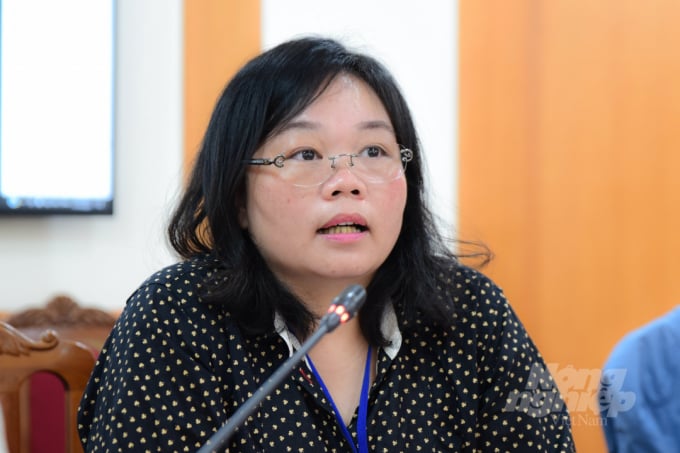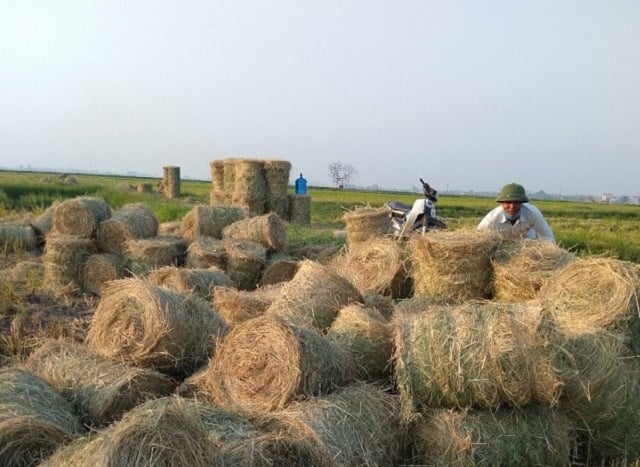November 26, 2025 | 23:29 GMT +7
November 26, 2025 | 23:29 GMT +7
Hotline: 0913.378.918
November 26, 2025 | 23:29 GMT +7
Hotline: 0913.378.918
According to the World Bank's final report on the Vietnam biomass atlas and statistics from the General Statistics Office, the total mass of theoretical by-products in 2020 exceeded 156 million tons, including over 88 million tons of post-plant harvest by-products from the horticulture industry (56.7 percent); and more than 61 million tons of cattle and poultry manure from the livestock industry (56.7 percent) (accounting for 10.6 percent).

Ms. Bui Thi Hong Ha, Head of Agricultural Microbiology Department, Center for Organic Agriculture (Vietnam Academy of Agriculture). Photo: VAN.
In crop production, for example, only around 52% of plants were gathered and utilized for other purposes, whereas approximately 56% of rice straw is collected and used for other purposes. Straw may be used for a variety of diverse applications and is even marketed on the international market.
However, tens of millions of tons of Vietnamese straw are still thrown away or burnt in fields, contaminating the environment. Assessing the potential and developing the appropriate technological solution to properly manage this by-product stream is a challenge for academics.
Ms. Bui Thi Hong Ha, Head of the Agricultural Microbiology Department at the Center for Organic Agriculture (Vietnam Agricultural Academy), said that numerous by-products remain in the field of agriculture.
Along with agricultural by-products, such as low-quality fruit that cannot be sold, can turn into massive waste that pollutes the environment due to insufficient knowledge on how to treat it into useful products among farmers. While agriculture is in great demand for fertilizer.
For rice, 1 ton of paddy collected equates to 1 ton of rice straw on the field; this represents a sizable resource that may be exploited. However, many are now dealing with it via burning... The issue is not so much with the enormous potential as with how to maximize it.
While farmers now have access to processing technologies, their access to current information and training remains limited. As a result, specialist units must educate farmers about the process.

Rice straw is a common by-product that can be usefully used for many different purposes. However, at present, tens of millions of tons of Vietnamese rice straw are still wasted or burned in the fields, polluting the environment. Photo: TL.
There is no demand for agricultural waste reuse by processing facilities. As a result, it is vital to focus on the management and promotion of chain connection creation to resolve this issue. Gardeners must be linked to industries (gardens need fertilizer, manufacturers require garbage) because, in addition to economic or noneconomic value, there is a significant environmental value.
Soonly scaling up the by-products processing model
According to Ms. Bui Thi Hong Ha, a noteworthy concept is processing rice straw directly on the padded field with biological products to make fertilizer rather than purchasing NPK fertilizer. People preserve straw without burning it and process it with biological products; even without the isolation time, they avoid organic poisoning caused by straw and lessen their reliance on fertilizers and pesticides. Rice plant protection...
According to the summary, if we leave all the rice straw on the field and maintain a low sowing density, we can cut fertilizer usage by 50% or pesticide use by 50%; in fact, many families now use no pesticides at all since there are no pests in the field. This strategy has been implemented in An Giang (50 hectares), Thai Nguyen (140 hectares), and Thanh Hoa (more than 100 hectares), and has garnered widespread acceptance and appreciation.

The utilization of agricultural by-products needs to be replicated soon. In addition to rice straw, discarded fruits are also a great resource that can be used as fertilizer. Photo: TL.
Ha also stressed the need to rapidly scale up the exploitation of agricultural by-products. There are some undisclosed studies on the potential for discarded fruits to be used to generate fertilizer. Certain regions with border crossings, like An Giang, have a high rate of mango discarding, resulting in environmental damage. However, the Center for Organic Agriculture (Vietnam Academy of Agriculture) researches and processes such wastes into fertilizer for the local government.
Regarding the model of processing agricultural by-products into organic fertilizer that has been successfully implemented in other countries, Ms. Ha added: "At the moment, certain countries' policies, such as those in the United States and Thailand, are not relevant, since their model is large-scale." On the other hand, nations have created environmental pledges and strategies for a circular economy when bringing products into production.
However, we may study and take lessons from the Thai government's strategy of encouraging link building, elegant and systematic models, and media coverage to convey the message. As a consequence, even in the absence of government backing, it is still viable to establish a rigorous circular economy model.
Additionally, we should undertake long-term research initiatives and make study findings publicly available to encourage others to do the same.
Translated by Linh Linh

(VAN) Tay Ninh’s livestock sector is undergoing a major transformation, applying high-tech, closed-loop circular models to build sustainable value chains.
/2025/11/26/3627-4-082628_818.jpg)
(VAN) From a small café on the red basalt highlands, Le Van Hoang started a business with clean coffee, building Enjoi Coffee into a symbol of organic agriculture in the Lam Dong plateau.
/2025/11/25/0045-1-135246_13.jpg)
(VAN) Ca Mau is researching a model of sea-encroaching embankments combined with viaducts and logistics service zones, aiming both to prevent erosion and create land funds for marine economic development.

(VAN) The information was shared at the seminar 'Urban Agriculture - Solutions for Developing Green Spaces,' organized by the Kinh te & Do thi Newspaper and the Biotechnology Center of Ho Chi Minh City.
/2025/11/19/4141-2-132831_216.jpg)
(VAN) One of Japfa's outstanding solutions is implementing digital transformation and artificial intelligence (AI) to optimize operations, enhance productivity, and advance sustainable development.
/2025/11/19/4847-1-093540_448.jpg)
(VAN) The Gia Lai Provincial People’s Committee had a working session with the delegation of the U.S. Department of Agriculture, the State of Idaho, and representatives of the State's leading enterprises.

(VAN) Ca Mau has a sufficient foundation to become a strong regional aquaculture center, where production integrates the economy, the environment, and the lives of the people.